Despite their familiarity, Great Cormorant and European Shag are still often confused, particularly by the inexperienced. Cormorant is also now known to consist of two very similar subspecies, one a traditional coastal bird, the other a recent colonist that prefers freshwater. Add to this an extreme Nearctic rarity, Double-crested Cormorant, and you have identification conundrums suitable for all levels of birder. Keith Vinicombe presents our definitive ID guide to help you sort out tricky subspecies, confusing coastal wanderers and a truly extreme vagrant.
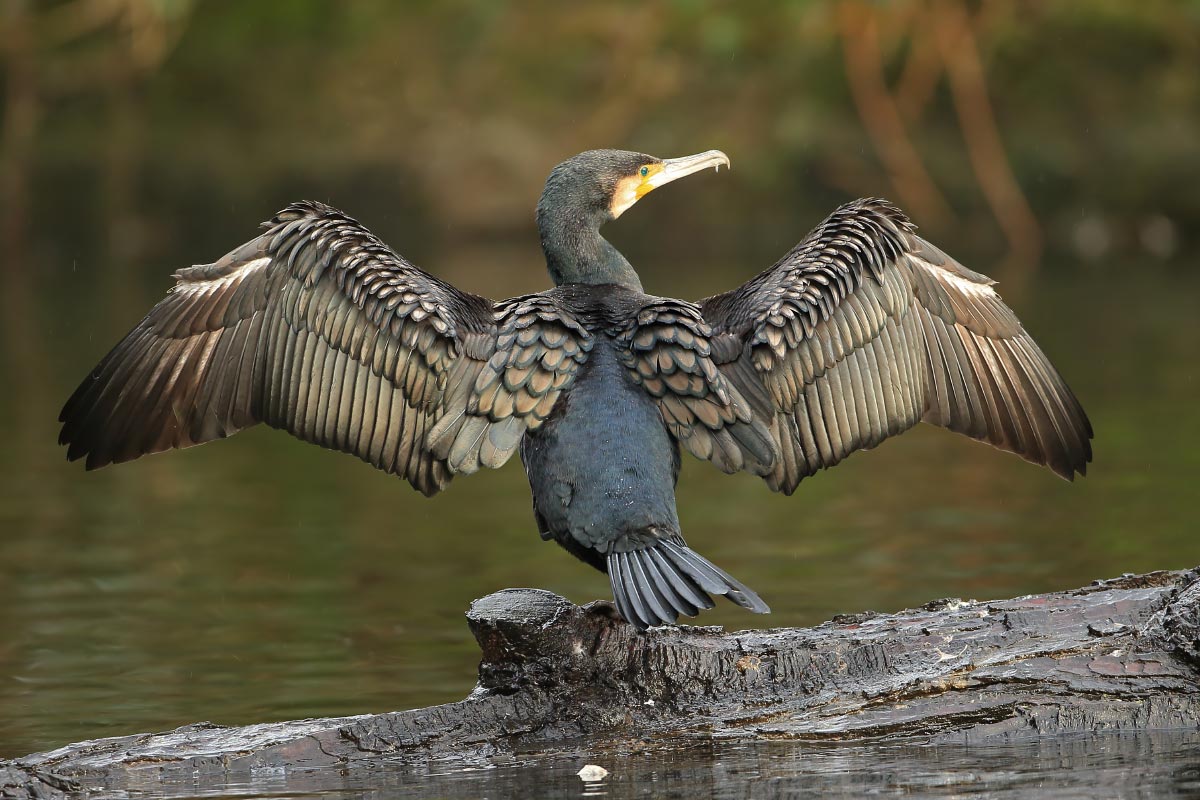
Adult Great Cormorant (Ipswich, Suffolk, 27 January 2014). With its hooked beak and oily black plumage, Cormorant has a rather prehistoric look and is unlikely to win any beauty contests. But as this photograph shows, on close views and in favourable light there is more to a Cormorant than meets the eye. When they catch the sun, the wings and scapulars show a strong green or bronze iridescence, with a neat darker border to most of the feathers. In summer plumage, white filoplumes – simple, hair-like feathers that grow in circles around the base of contour or down feathers – can be striking on the head, as can the white face and flank patches, while the bare yellow facial skin – which turns bright orange-red and olive-green in full breeding condition – adds a splash of colour (Robin Chittenden).
Great Cormorant is a common, familiar and widespread species in both coastal and inland habitats throughout much of Britain, even in the centre of cities. The original British Trust for Ornithology Atlas of Breeding Birds in Britain and Ireland (with fieldwork carried out 1968-72) showed it to be a widespread breeder, with just over 8,000 pairs on rocky coasts, although it was absent from the east and south coasts of England between Yorkshire and the Isle of Wight (Sharrock 1976). The Bird Atlas 2007-11 revealed a similar coastal distribution, but confirmed that inland breeding was also occurring across a large swathe of lowland England (Balmer et al 2013).
Great Cormorant
Historically, Great Cormorant populations in Britain and on the near-Continent have been kept at a low level by a combination of human persecution and pesticide pollution, but following legal protection in Denmark and The Netherlands during the 1960s, the European population increased dramatically.
Continental birds are of a different subspecies from those in Britain: sinensis as opposed to nominate carbo. A significant difference is that, whereas carbo nests on coastal cliffs, sinensis nests in trees. This simple fact has accounted for a 53 per cent range expansion in Britain since the first nesting by sinensis in 1981 (at Abberton Reservoir, Essex).
By 2005 there were an estimated 2,100 pairs of sinensis nesting in Britain. However, since the establishment of inland tree nesting by sinensis Great Cormorants, nominate birds have also started to breed inland, particularly in those sinensis colonies that are older and well established (Newson et al 2007).
So how do you separate them? The nominate form averages larger than sinensis, but there is overlap in their measurements, not least because in both taxa males are larger than females. A large male carbo may appear strikingly bigger and heavier than a small female sinensis, which may look petite and positively Shag-like in comparison, but with many individuals, size differences are not obvious. Older literature often suggests that, in full breeding plumage, sinensis has more white on the head than carbo, but we now know that this is not reliable.
The only sure way to separate them is by the shape of the bare skin on the face, known as the 'gular patch'. On carbo, the bare skin slopes forward from the base of the gape towards the base of the lower mandible, often with a distinct upward bulge in the lower border of the feathering. On sinensis, the rear edge of the bare skin drops vertically from the gape line to the throat, forming a distinctly square gular patch, as opposed to a more pointed one on carbo. To put it another way, the bare skin on carbo has an acute angle at the base of the gape, whereas on sinensis it has an obtuse angle.
However, confirming this difference in the field can be frustratingly difficult. Unless the birds are at close range and standing still with their heads side on, it can be very hard to make out the precise pattern. In addition, loafing Great Cormorants spend a lot of time either preening or sleeping (with their bills tucked into their scapular feathers) rendering it extremely difficult to confirm the facial pattern one way or the other.
Another problem is that sinensis birds often hold their bills pointed upwards at an angle, giving the impression that the right angle in the gular patch is acute. Additionally, there has also been a certain amount of interbreeding between carbo and sinensis, so many intermediate-looking birds are impossible to assign to form.
European Shag
Identifying cormorants to subspecies level may not be everybody's cup of tea, but separating Great Cormorants from European Shag is more fundamental. Shags are birds of rocky coastlines, but they disperse more widely around the coast in winter and occasionally turn up inland, sometimes after gales but also in quite calm conditions.
European Shag is in fact more numerous than Great Cormorant, with an estimated wintering population of 110,000, compared with 35,000 Cormorants (Musgrove et al 2011). Shags are generally much tamer than cormorants, although in urban areas the latter are also becoming increasingly approachable. Nevertheless, any unusually confiding 'cormorant' at an inland locality is always worth a second look.
In flight, European Shag flies with its thin neck stretched out, whereas Great Cormorant has a heavy head and neck, the latter showing a distinct kink. As a general rule, Shag flies low over the water, with relatively pointed wings, whereas the heavier, more substantial, more goose-like cormorant often flies at some height, frequently in long, straggly V-shaped flocks. Inland birds often soar.
Double-crested Cormorant
There is a third species of cormorant on the British list: Double-crested Cormorant from North America. The only record to date was of a long-staying first-year at Charlton's Pond, Billingham, Co Durham, from 11 January to 21 April 1992. Initially, it was variously identified both as a Cormorant and a Shag before, to his great credit, Terry Williams eventually concluded that it was Britain's first Double-crested (Williams 1996). This was followed by one in Ireland at Nimmo's Pier, Co Galway, from 18 November 1995 to 6 January 1996. Since then: nothing!
As there have been at least 60 now reported from the Azores, it is perhaps surprising that there have not been more recorded here. The problem, of course, is picking one out from the widespread and abundant Cormorant, and this challenge has become exacerbated in recent years by the spread of sinensis, which is far more similar to Double-crested than the traditionally occurring carbo.
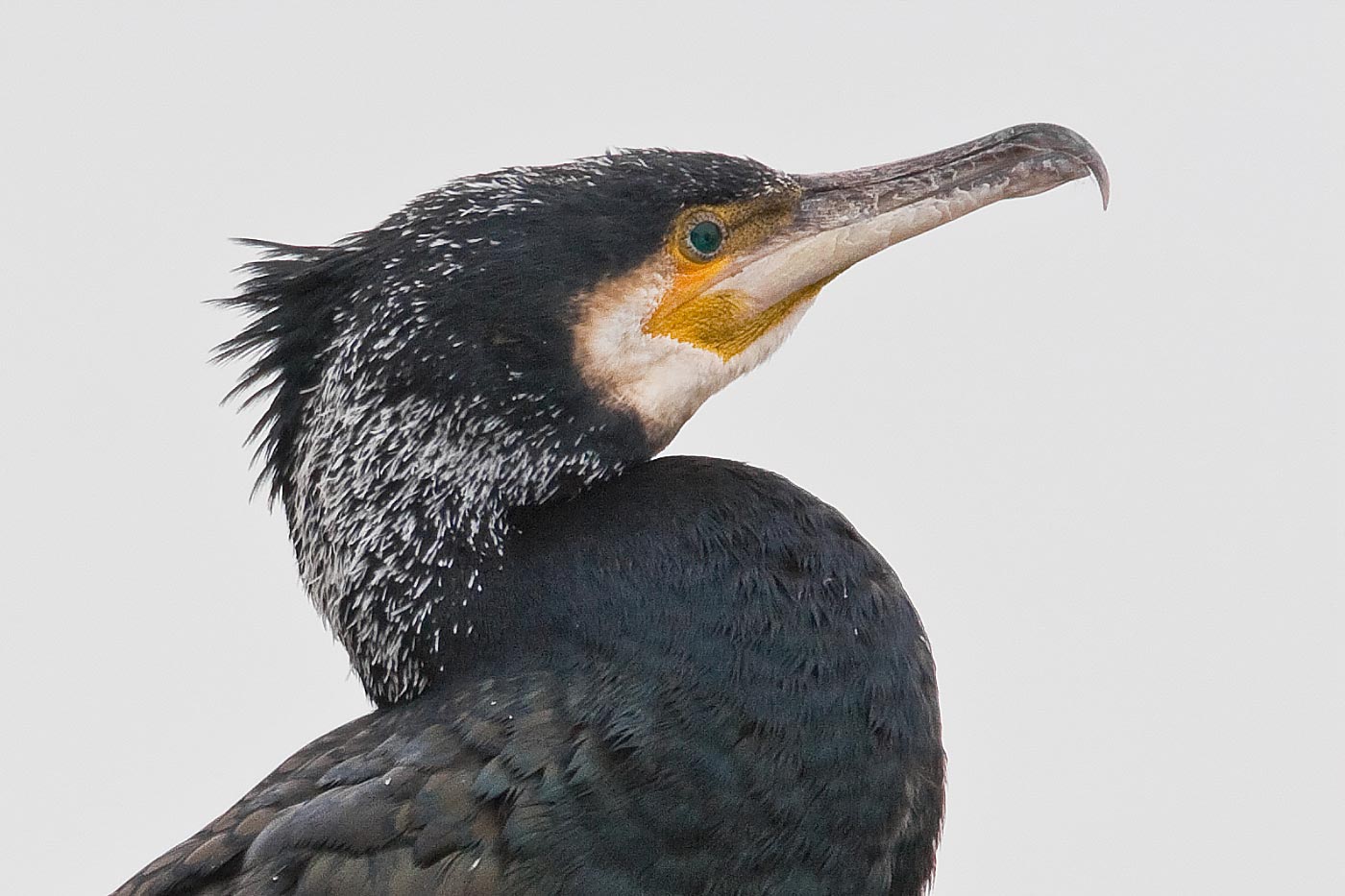
Adult Great Cormorant (Slapton Ley, Devon, 30 January 2007). Cormorant is a large, hefty bird. Males are bigger than females, with adult male carbo being up to 1.7 times heavier than the smallest adult females. It shows a thick, hefty, hook-tipped bill and a distinctly wedge-shaped head and bill profile, with a strong angle at the back of the head, adorned in breeding plumage by a spiky crest. This January adult is acquiring white filoplumes on its head (as well as a white flank patch), both features of breeding plumage. Note the shape of the orangey-yellow facial patch: it is strongly pointed where the gape meets the facial feathering, a feature diagnostic of nominate carbo (Howard Bottrell / www.ecovisuals.com).
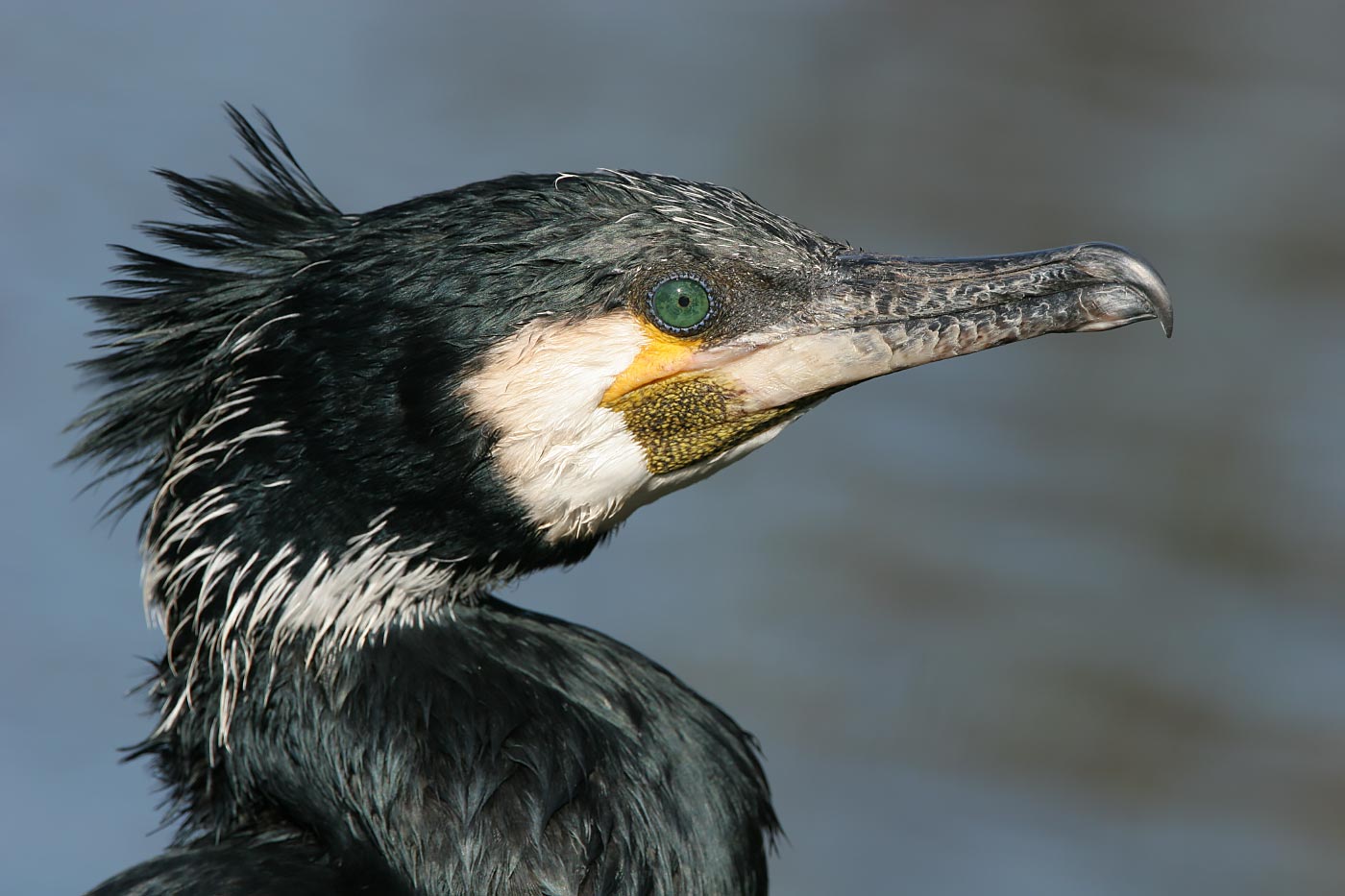
Adult Great Cormorant (Katwijk, The Netherlands, 9 April 2007). This bird shows distinctive white filoplumes on its nape and neck sides, a feature of breeding plumage. The extent of the white has traditionally been touted as a way of separating carbo and sinensis, but this is now known to be unreliable. The only safe way to differentiate them is by the shape of the bare gular patch below the eye. On this bird, the border between the bare skin and the white facial feathering is vertical, resulting in a rather square patch below the gape line. This is characteristic of sinensis. Remember, however, that interbreeding occurs, with the intermediate-looking offspring being unidentifiable to form (Menno van Duijn / www.agami.nl).
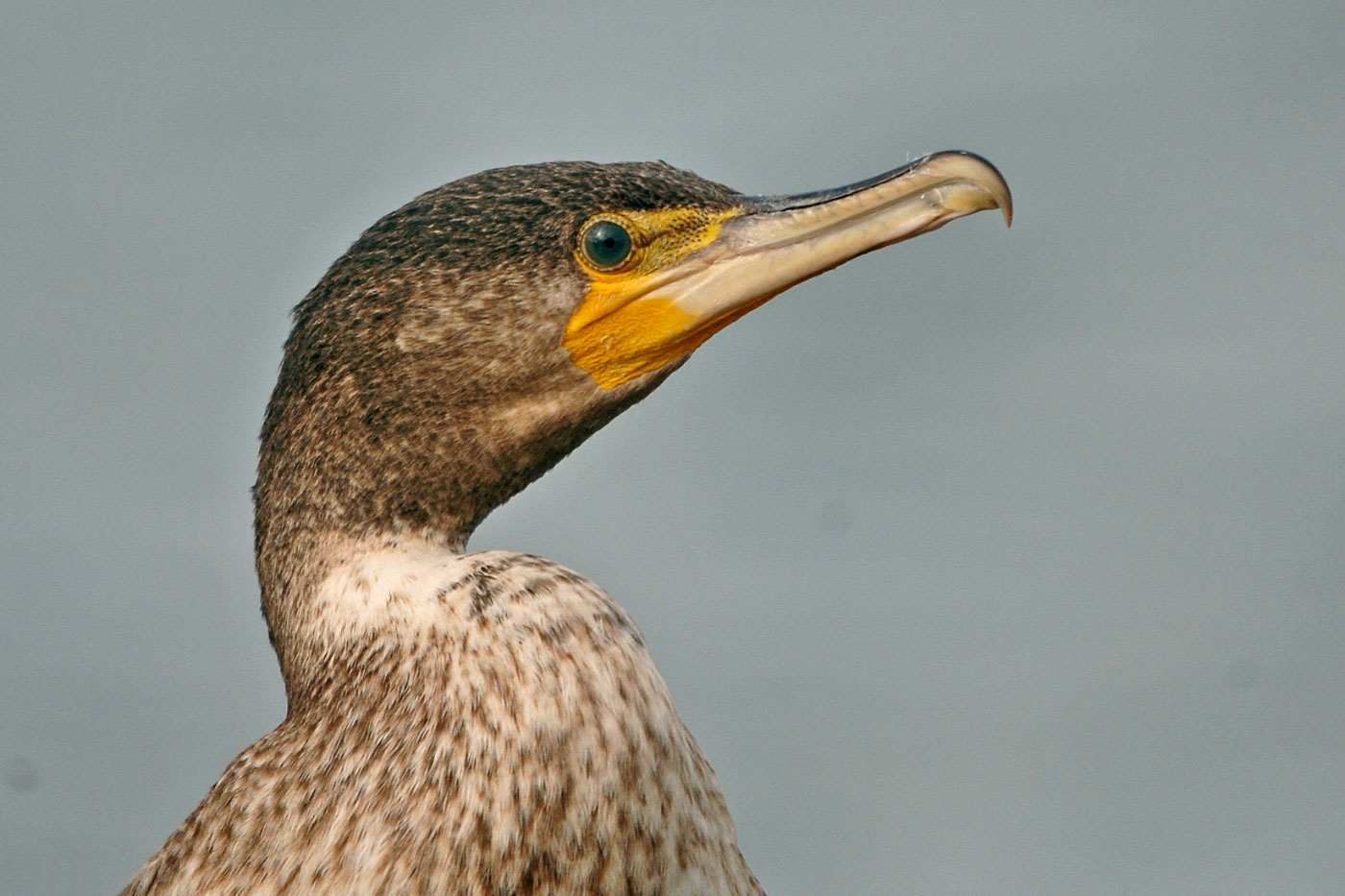
Juvenile Great Cormorant (Seaforth, Lancashire, 8 October 2006). This bird can be identified as sinensis by the shape of the gular patch, the rear border dropping vertically from the gape to the throat. This form often shows a beady-eyed effect, which seems to be less usual on carbo, possibly because the latter tends to show more dark on the lores. With its rather petite structure and orange-tinted gular patch, this bird is not dissimilar to Double-crested Cormorant (below). This impression is enhanced by its pale face and upper breast. However, note the forward extension of its brown throat feathering into the underside of the gular patch, which Double-crested lacks (Steve Young).
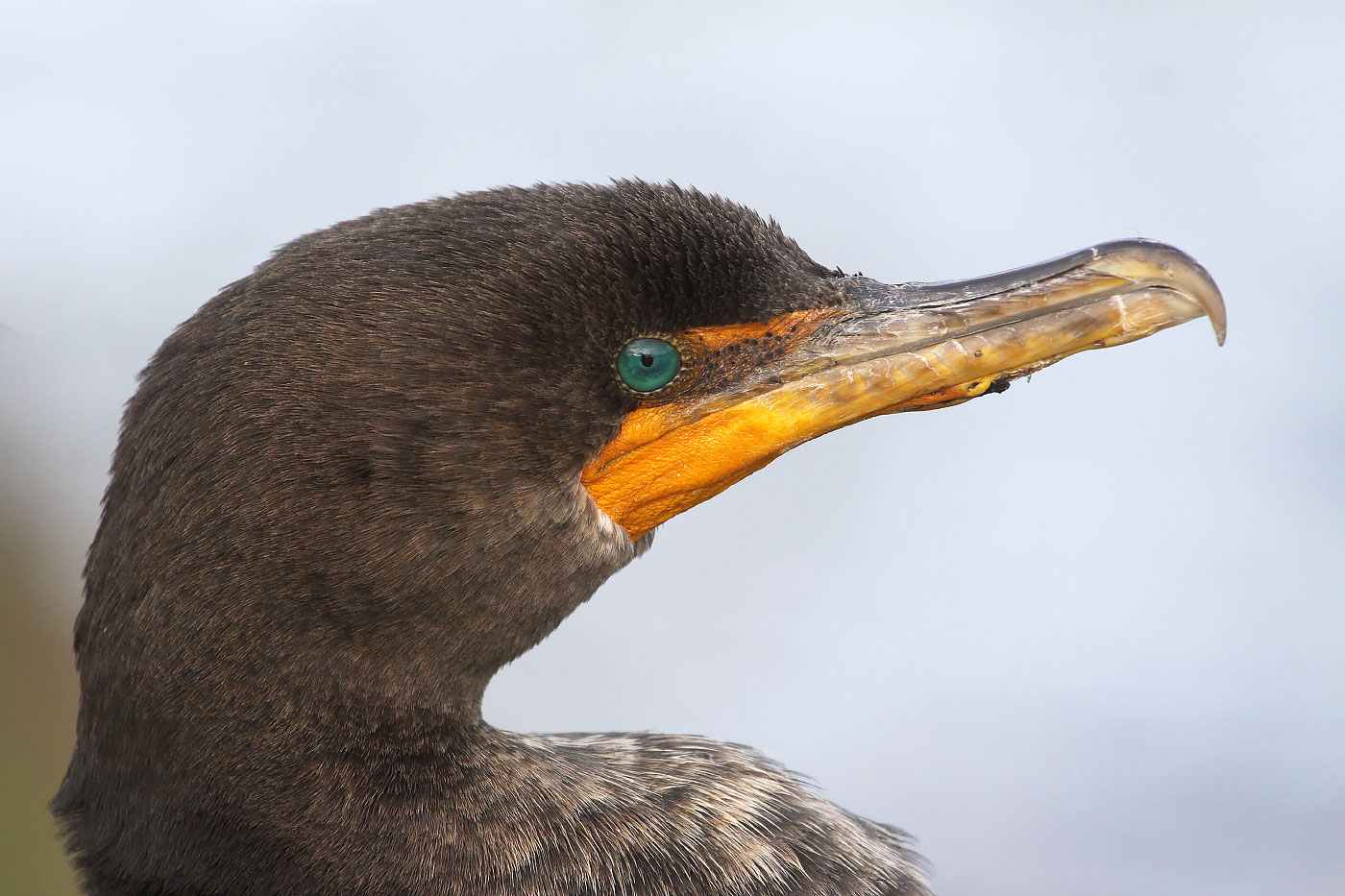
Juvenile Double-crested Cormorant (Florida, USA, 3 January 2014). Double-crested is similar to sinensis Cormorant (above) in that the rear border of the bare facial skin drops vertically from the base of the gape, but the skin generally appears more orange in tone. There are minute black feathers across the lores, but above those is a rather clear-cut and discrete orange line, which is fairly typical. The two most important features are the orange-yellow on the face extending along the bill, most prominently along the lower mandible, and unlike Cormorant, there is no forward extension of the throat feathering into the underside of the gular patch (Peter Dedicoat).
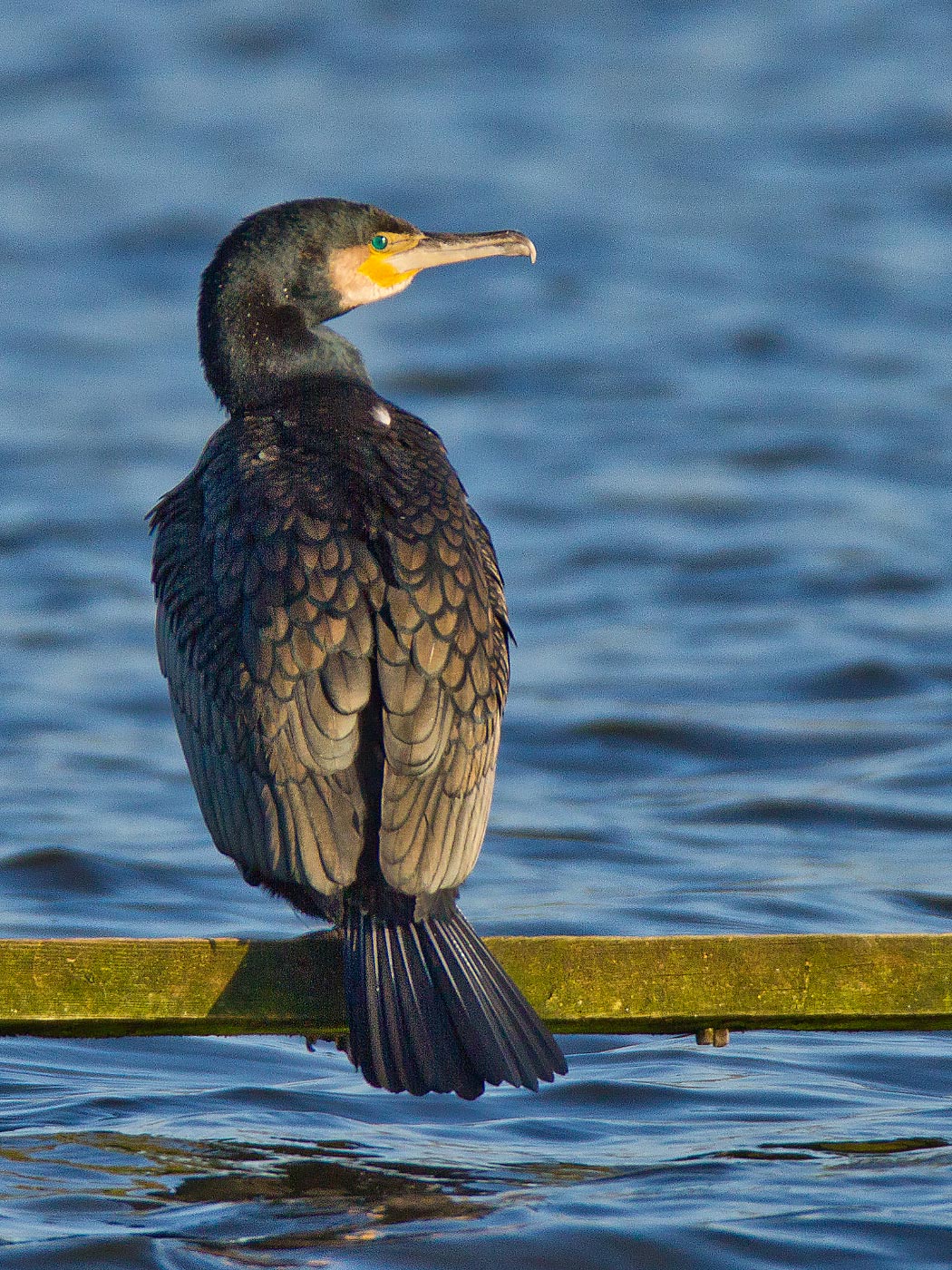
Adult Great Cormorant (Upton Warren, Worcestershire, 1 February 2012). On this bird, the border of the feathering behind the bare gular patch slopes forward, so there is an acute angle in the feathering at the base of the gape, identifying this bird as nominate carbo; on sinensis, there is an obtuse angle. Although carbo averages larger than sinensis, males of both forms are larger then females, so a large male sinensis may actually be larger than a small female carbo. Despite this, many sinensis appear distinctly small, slight and quite Shag-like in shape and structure, with a slimmer bill and a more rounded head than carbo (Howard Bottrell / www.ecovisuals.com).
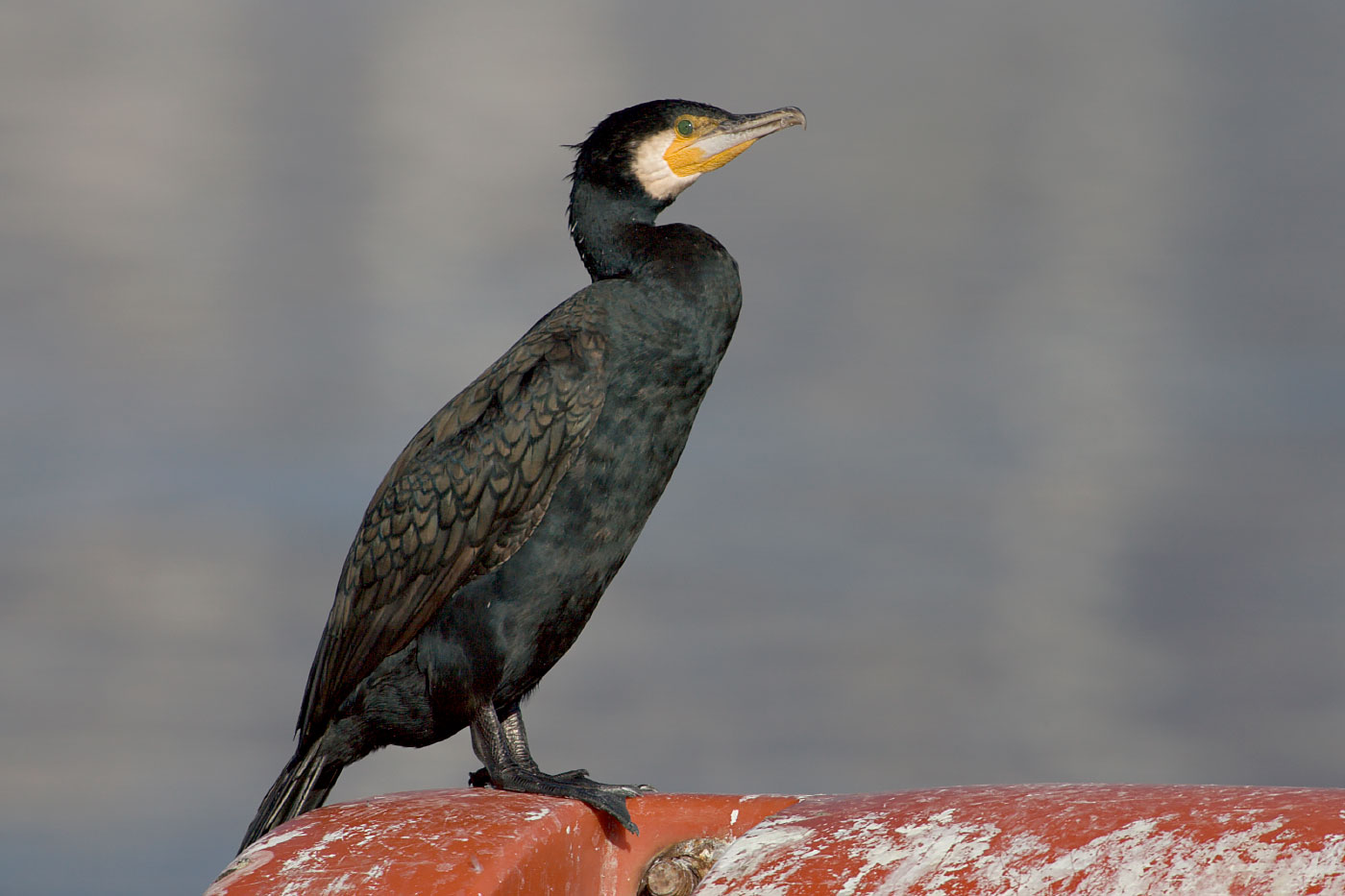
Adult Great Cormorant (Tuscany, Italy, 31 December 2004). This sinensis is in winter plumage, lacking a white flank patch and obvious white filoplumes on the head. Note the shape of the gular patch: the dividing line between the yellow skin and the white facial feathering is vertical, producing an obtuse angle at the gape rather than the sloping diving line and acute angle seen on carbo. Compared with Double-crested, note the whitish colour of the lower mandible (as opposed to yellow) and the forward extension of the pointed throat feathering into the underside of the gular patch; this is lacking in Double-crested (Daniele Occhiato / www.agami.nl).
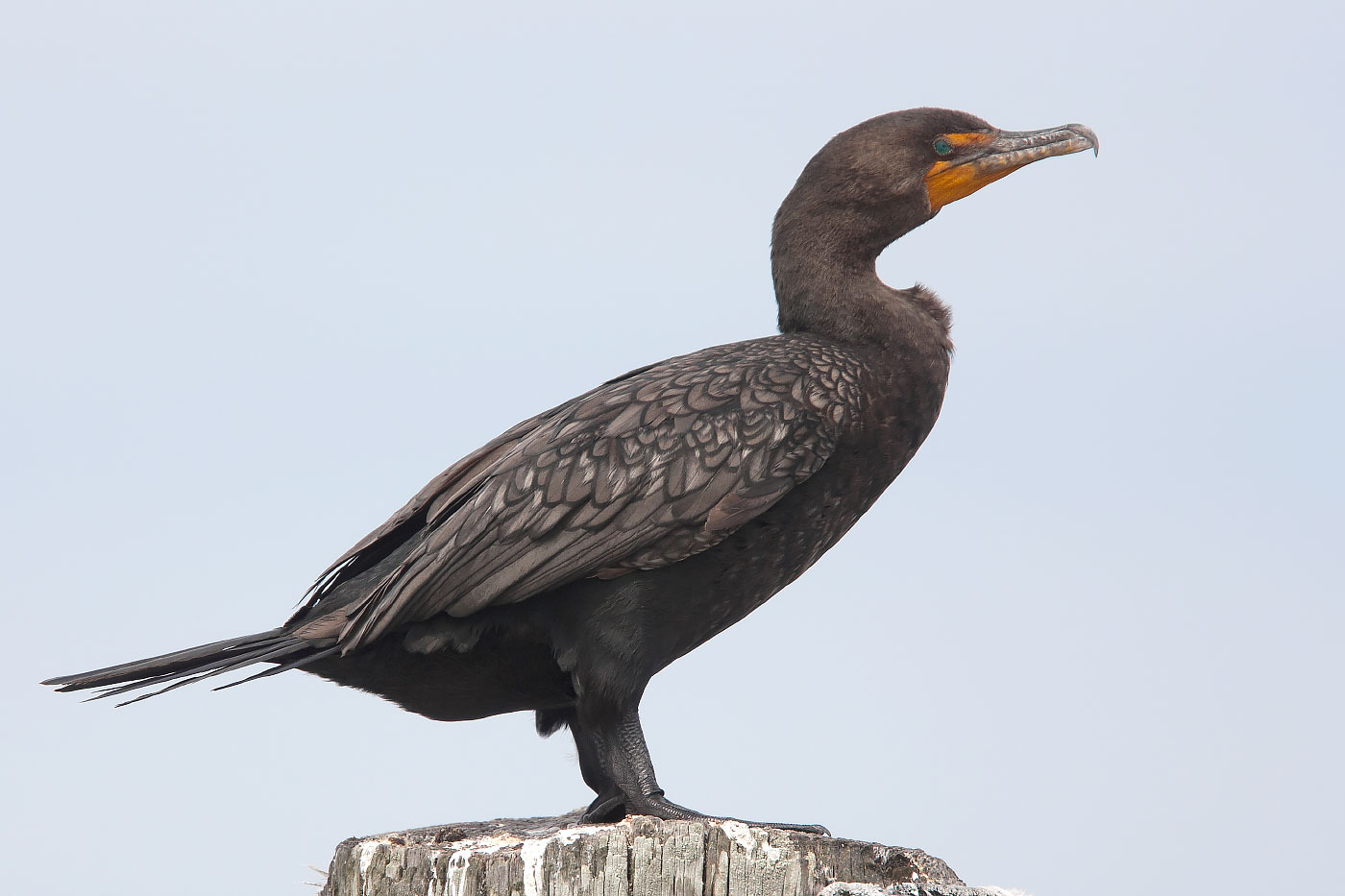
Adult Double-crested Cormorant (New Jersey, USA, 7 September 2009). Double-crested's small size, rounded head, short neck and rather short bill give it a compact shape compared with Cormorant. There is, however, overlap in the weights of Double-crested (1.2-2.5 kg) and sinensis (1.7-2.8 kg), while the largest male Double-crested (2.5 kg) can be heavier than the lightest female carbo (2.1 kg). Note the deep orange face, with a prominent black line between the bill and eye isolating a distinct orange line above, and the complete lack of a wedge of throat feathering protruding into the underside of the gular patch (Tony Mills).
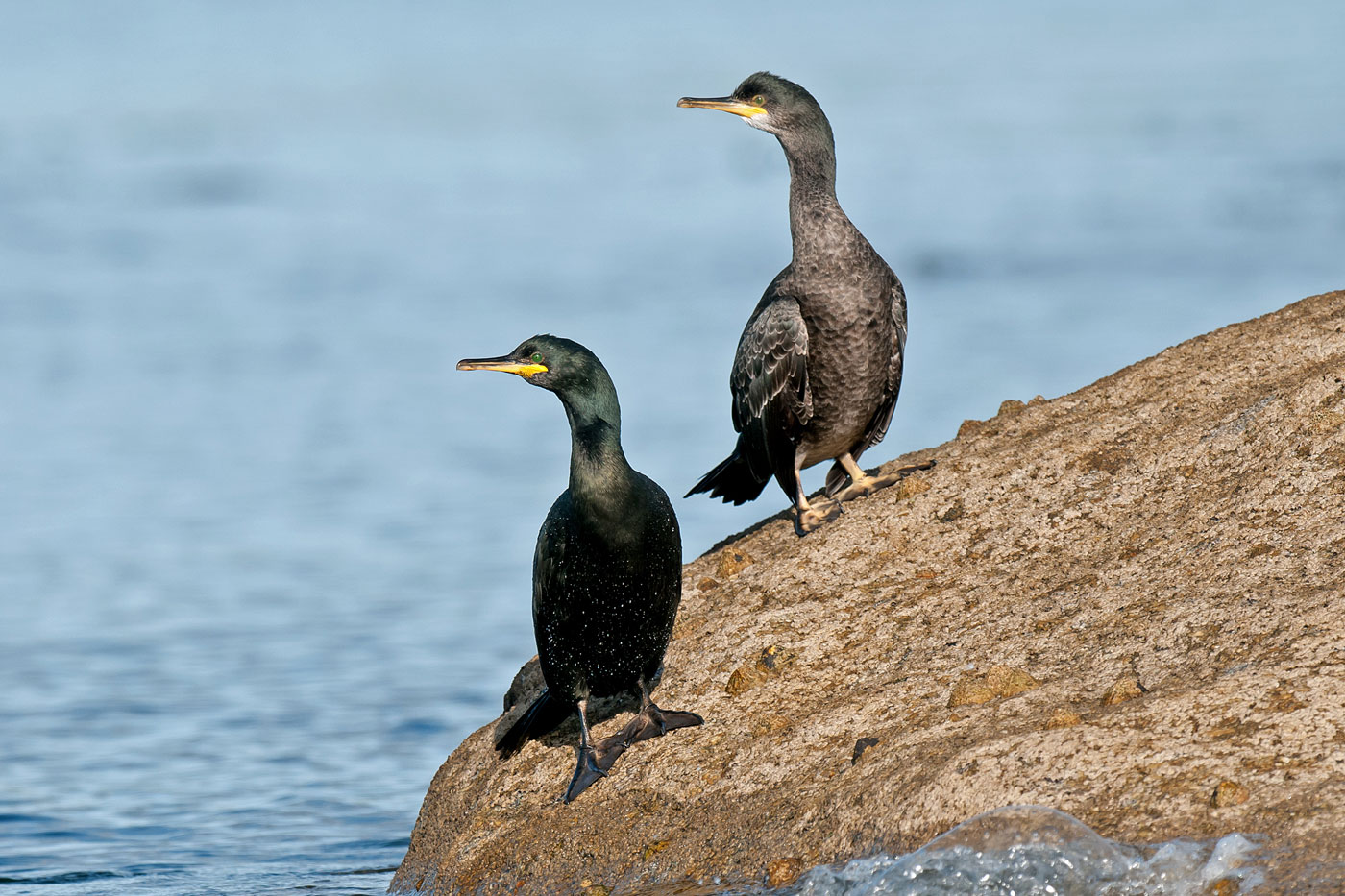
Adult (left) and juvenile (right) European Shags (Scilly, 13 October 2009). Compared with Cormorant, Shag is altogether smaller, slighter and daintier, although some small sinensis Cormorants (presumably females) can look distinctly Shag-like. Note in particular the slim bill and steeper forehead, which often shows a distinct crested effect to the fore-crown. The neck is thinner than Cormorant's and it is held straight out in flight, lacking the latter's thicker, rather kinked neck profile. Juveniles are distinctly brown and show a characteristic whitish chin and pale fringes to the wing coverts. At all ages Shag lacks Cormorant's bare-skinned gular patch; instead, the conspicuous bright yellow gape line extends back below and behind the eye (Steve Young).
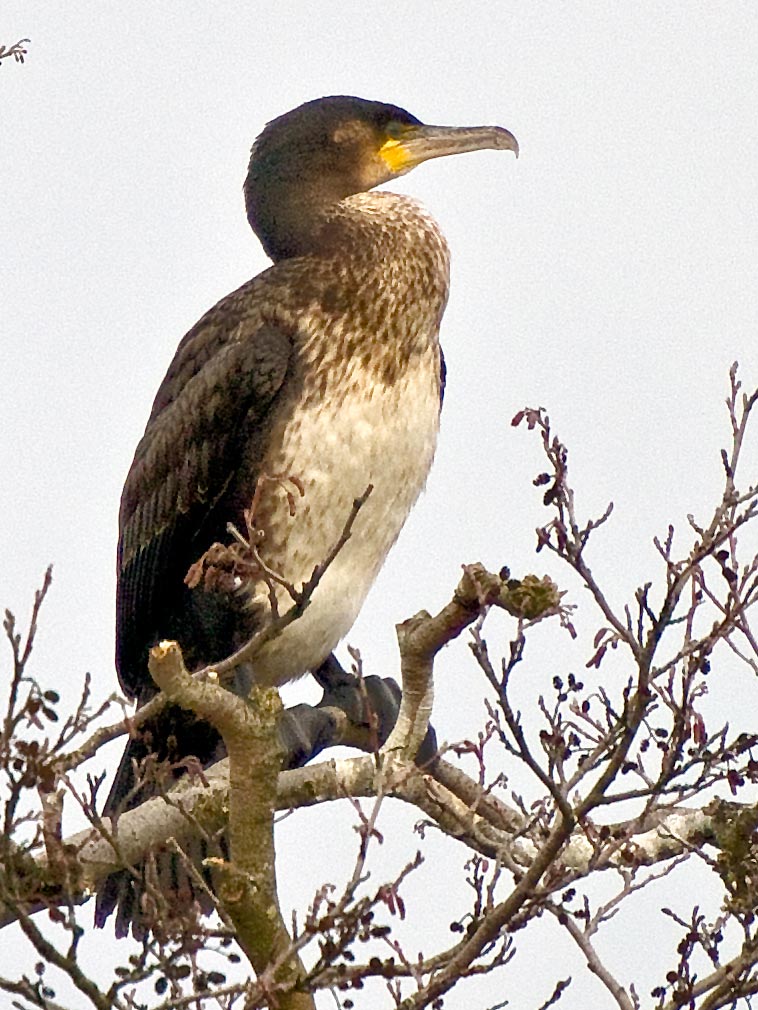
Juvenile Great Cormorant (Stover CP, Devon, 10 March 2005). Juvenile Cormorants show considerable individual variation: many are brown below, but others, like this bird, are very white. From late summer onwards, they moult their body feathers continually until the end of their second calendar year. One moult often continues on one part of the body while the next has already started on another (BWP). They first breed at the age of 2-4 years and, because of their continual moults, adolescent Cormorants inevitably appear rather scruffy and 'moth-eaten'. It is extremely difficult to age such birds as anything other than 'immature' (Howard Bottrell / www.ecovisuals.com).
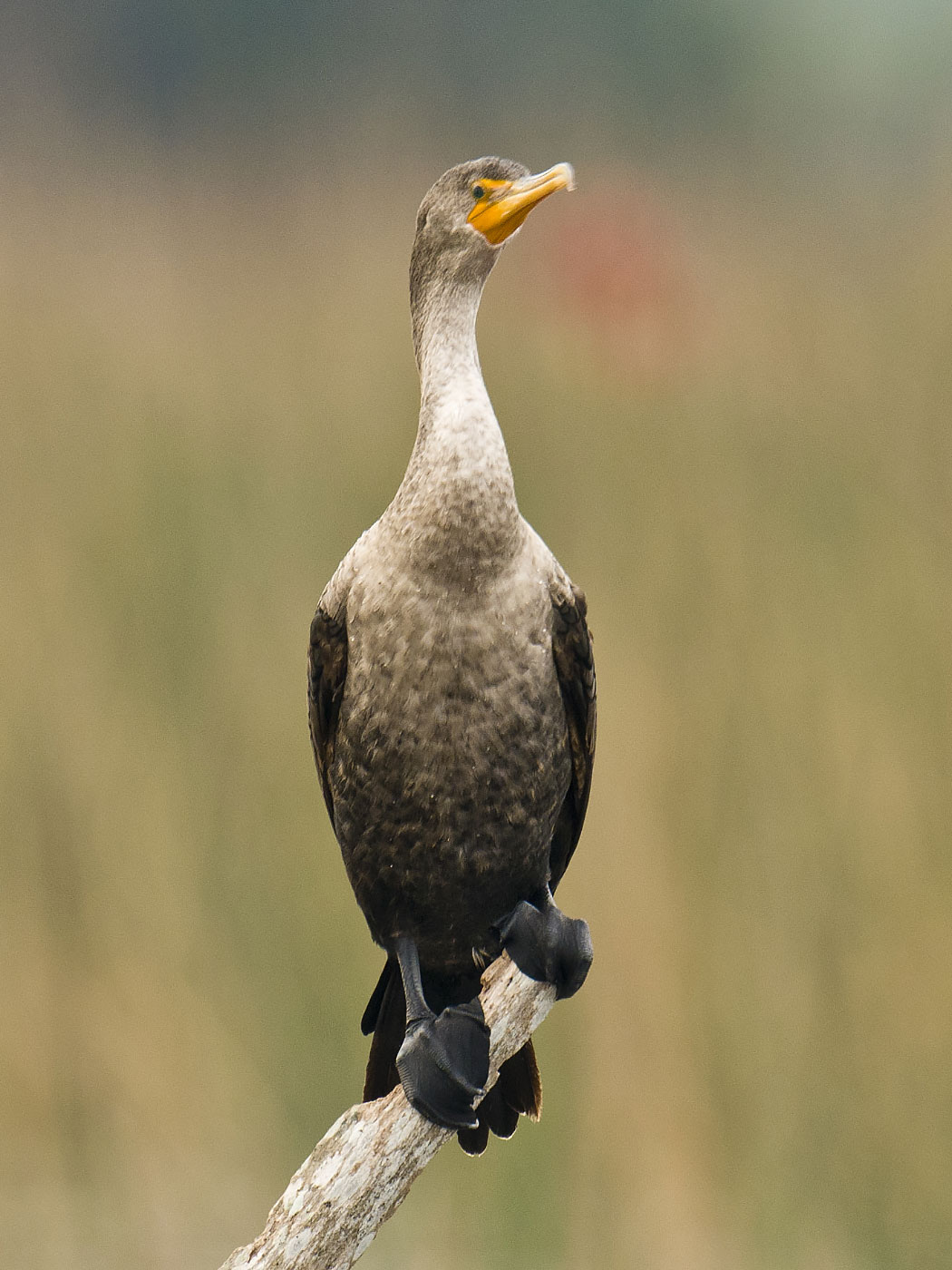
Juvenile Double-crested Cormorant (Florida, USA, 31 January 2011). Juvenile Double-crested shows a very pale neck and upper breast, which contrast with the much darker belly. The face is bright orangey-yellow, with a dark line across the lores, above which is a well-defined orange-yellow line. However, a small minority of Cormorants show a very similar colour and pattern. Two key features should be checked: on most, the lower mandible will be yellow, unlike the horn-coloured lower mandible of Cormorant, and Double-crested completely lacks Cormorant's forward-pointing extension of the chin feathering into the gular patch (E J Peiker / BIA).
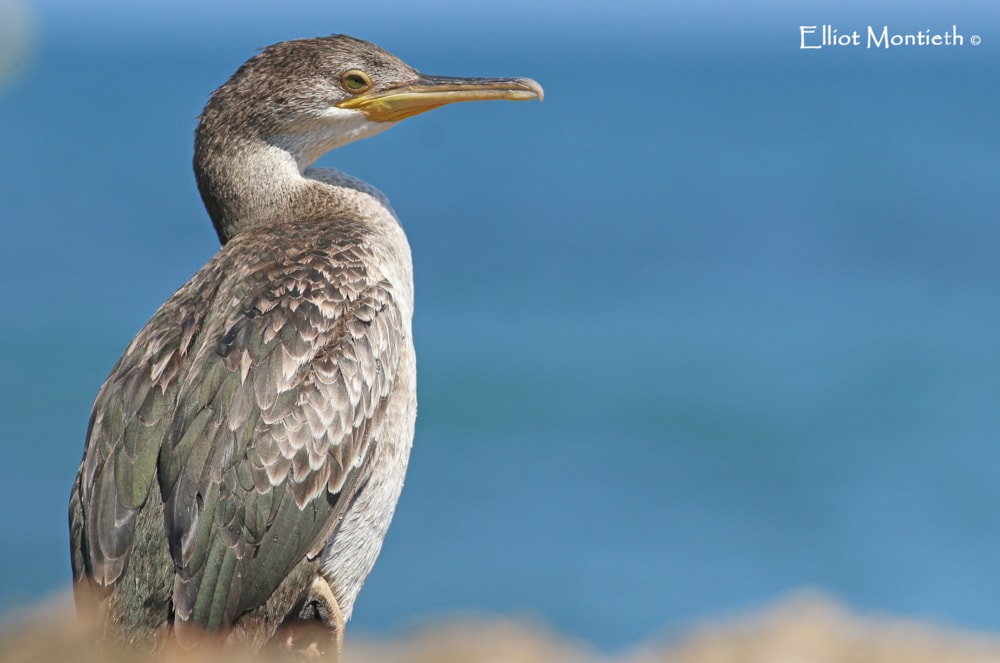
European Shag (Javea, Spain, 1 July 2018). In the Mediterranean and Black Seas, there is a different form of Shag: desmarestii. Adults are similar to nominate aristotelis, but juveniles are strikingly different. They are much paler, being whitish below and pale brown above, with prominent whitish fringes to the wing coverts. Their legs and feet are noticeably pale pinkish (black on aristotelis). Surprisingly, such birds are not infrequent in south-western England, particularly in Cornwall and Scilly, where intermediate-looking individuals may also be seen. Given the frequency of their occurrence, it seems more likely that, rather than originating from the Mediterranean, similarly plumaged birds are occasionally produced by our own native population (Elliot Montieth).
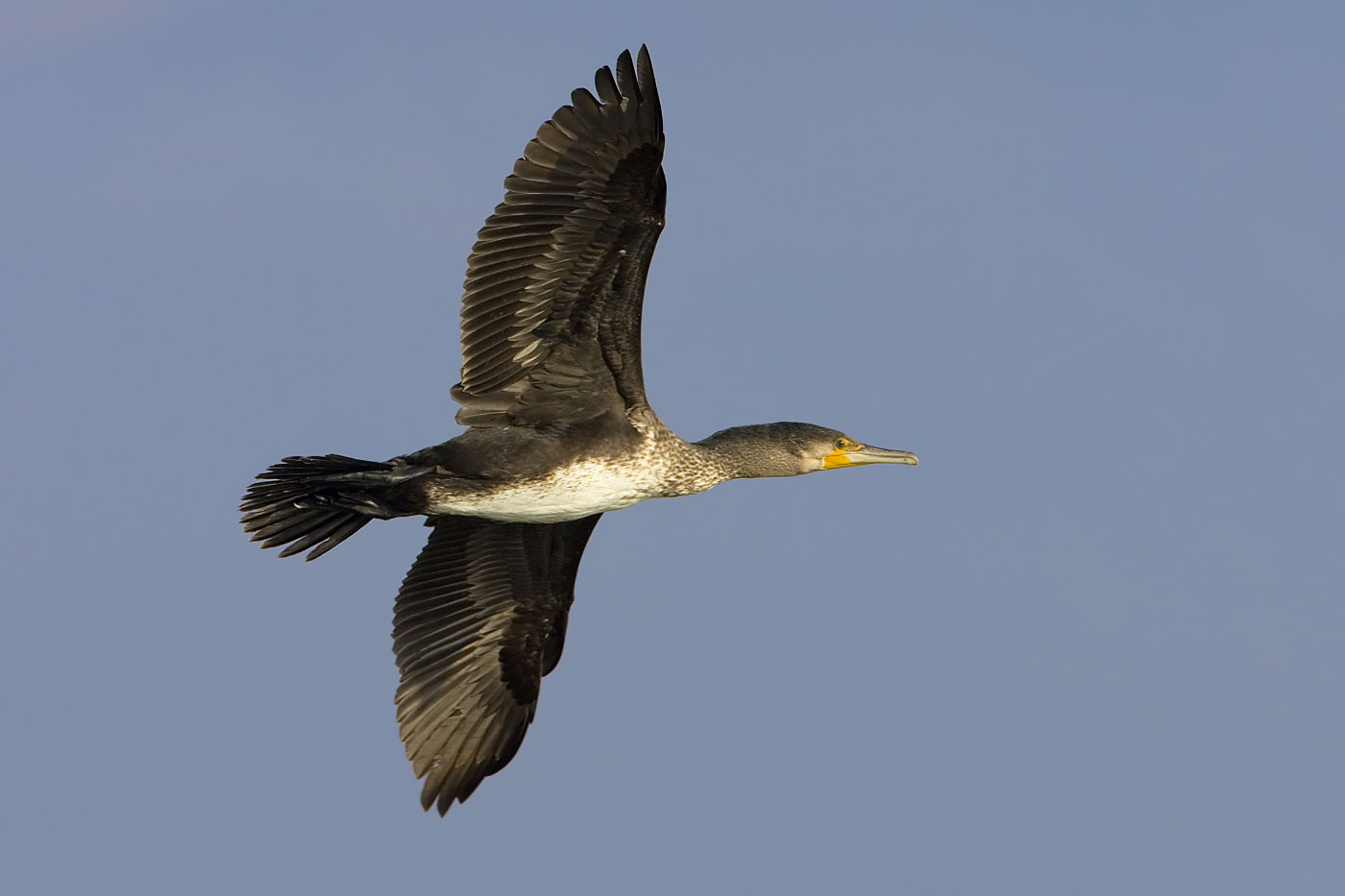
Juvenile Great Cormorant (Tuscany, Italy, 26 November 2006). The striking white belly, combined with its size and structure, would enable confident identification and ageing as a juvenile Cormorant, even at a distance. Cormorants appear rather goose-like in flight, this being enhanced by the fact that flocks often fly in long, straggly 'V' formations. However, distant birds can be easily separated from geese by their frequent gliding. Inland birds also soar from time to time. The heavy head and distinct neck kink are obvious differences from Shag (Daniele Occhiato / www.agami.nl).
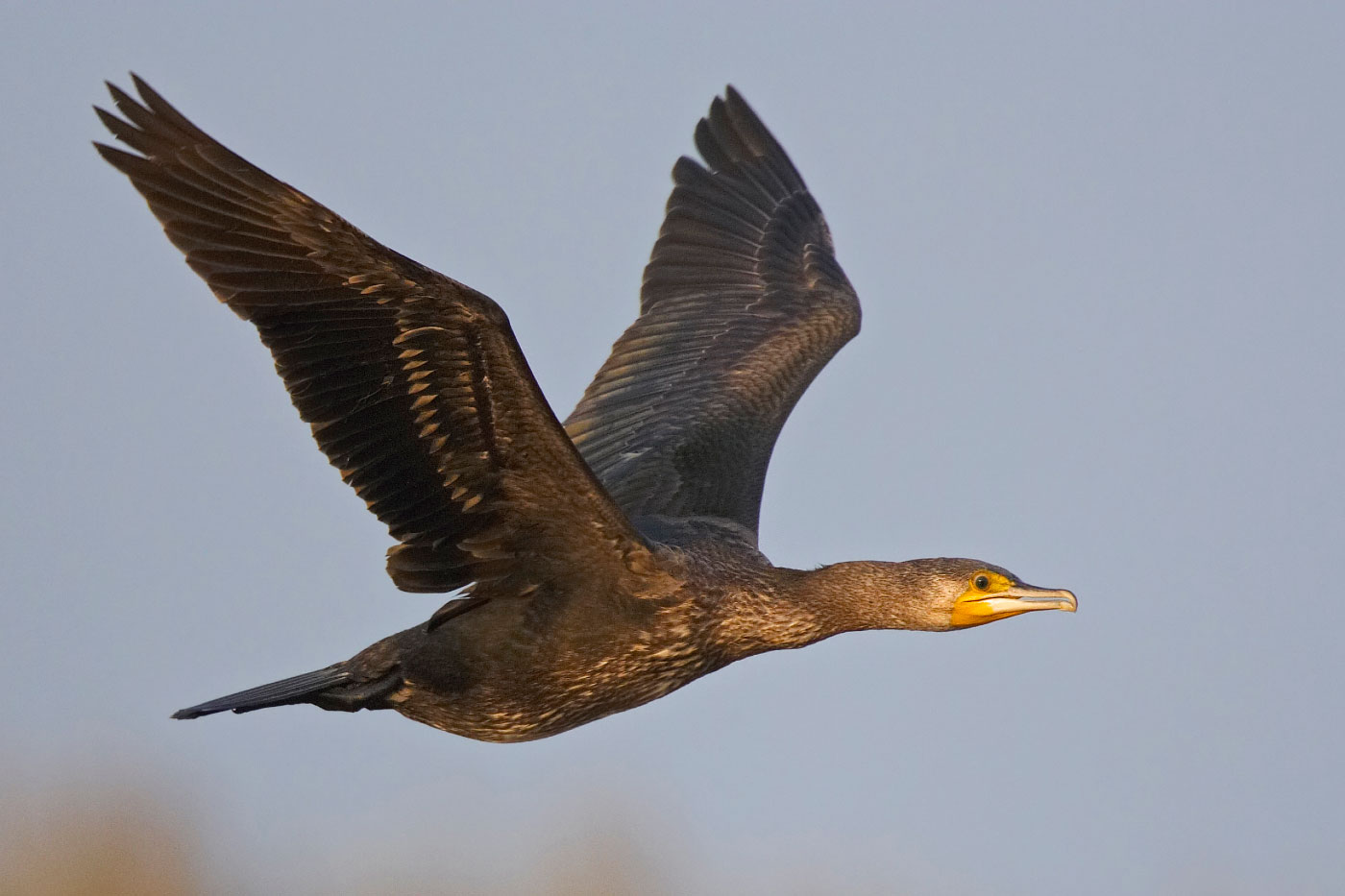
Juvenile Great Cormorant (Falsterbo, Sweden, 26 September 2005). Comparing this image with the photo below, the similarity between sinensis Cormorant and juvenile Double-crested is obvious. As sinensis averages smaller than carbo, it is much more similar in size to Double-crested. Not only that, it also has a similar facial appearance with a square gular patch. This bird's body plumage is also comparable in that its face and fore-neck are slightly but distinctly paler than the belly. Some are even paler than this, bearing a superficial similarity to Double-crested. Sinensis normally lacks Double-crested's thick dark line between the bill and the eye, appearing rather beady eyed as a consequence (Markus Varesvuo / www.birdphoto.fi).
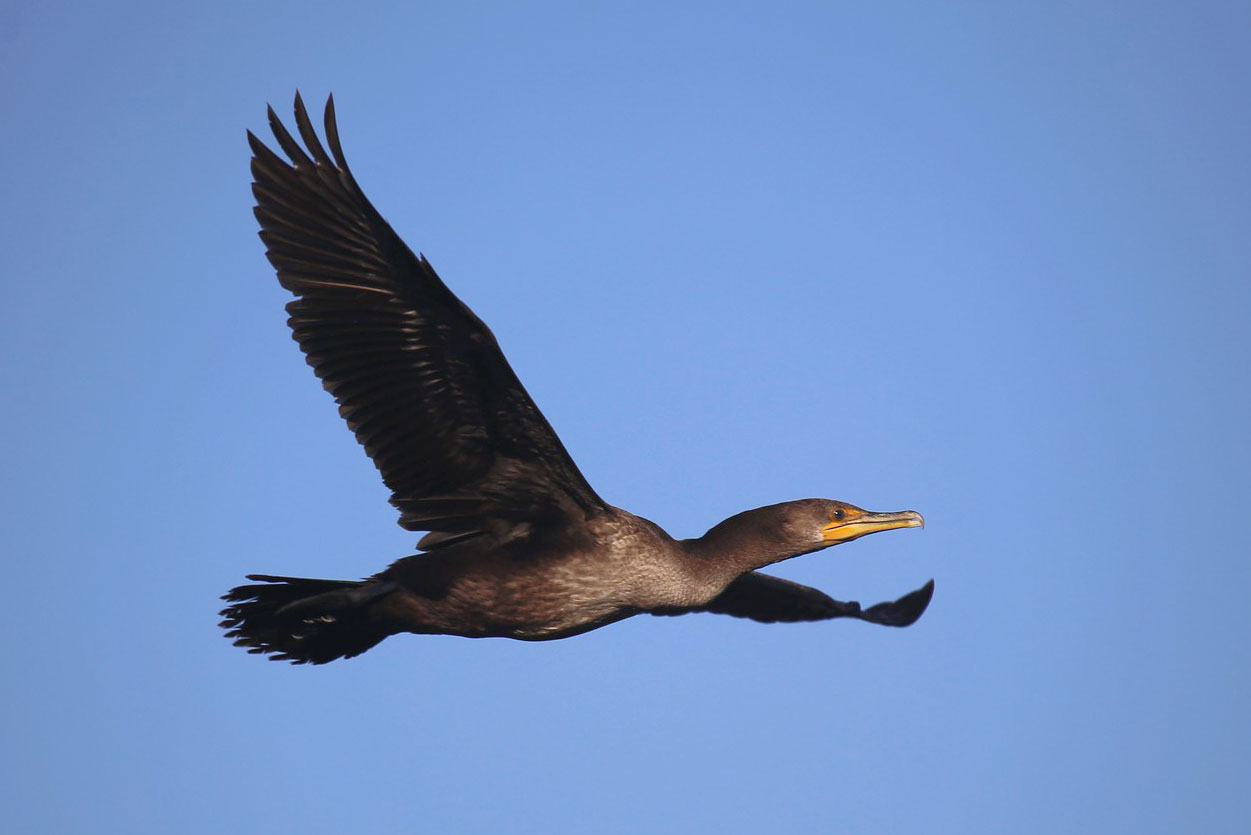
Juvenile Double-crested Cormorant (Florida, USA, 18 December 2014). Comparing this photograph with the sinensis in the preceding image, Double-crested differs in that it usually shows a dark band across the lores, between the bill and the eye, with a discreet orangey-yellow band of bare skin above it. However, some sinensis are similar, and note also that the tiny feathers that make up Double-crested's dark line can wear away. It also has a predominantly yellow lower mandible and lacks the forward-projecting area of throat feathering into the underside of the gular patch. Note too that not all juvenile Double-cresteds have a strikingly pale upper breast and neck; many, like this bird, are quite dark (cuatrok77 / Flickr).
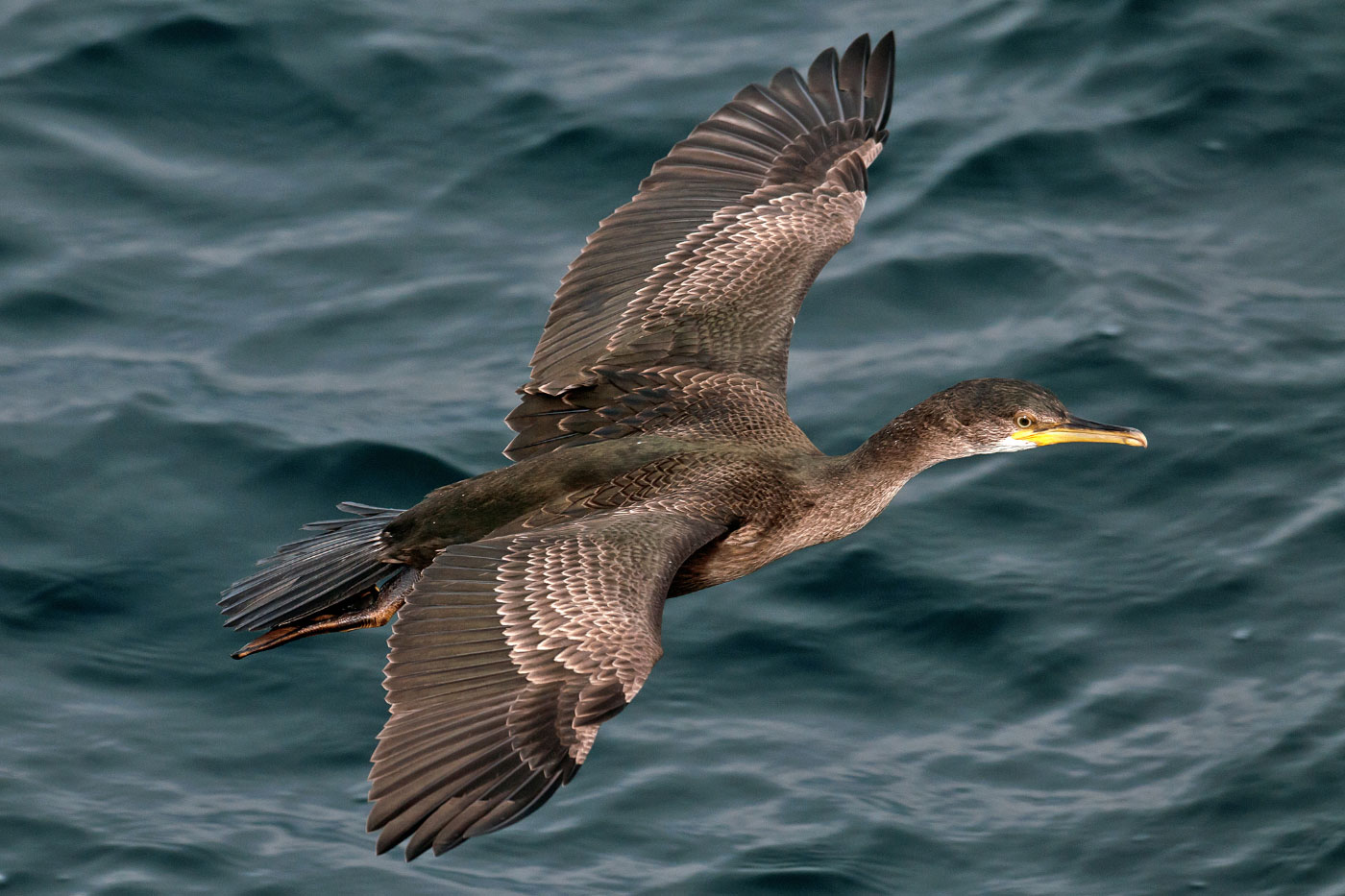
Juvenile European Shag (Orkney, 26 September 2009). In flight, Shag shows a small head and a thin neck, which is held straight out from the body, lacking Cormorant's distinct neck kink. It invariably flies low over the sea, whereas Cormorant often flies at a considerable height. Juvenile Shags are easily identified by their pale brown plumage, with very distinctive whitish fringes to the wing coverts. These may stand out as a pale panel on the open wing, particularly by the first spring and summer when the panel may become very striking as the feathers bleach whiter. This photograph also shows the juvenile's pale eye and distinctive white chin and throat (Steve Young).
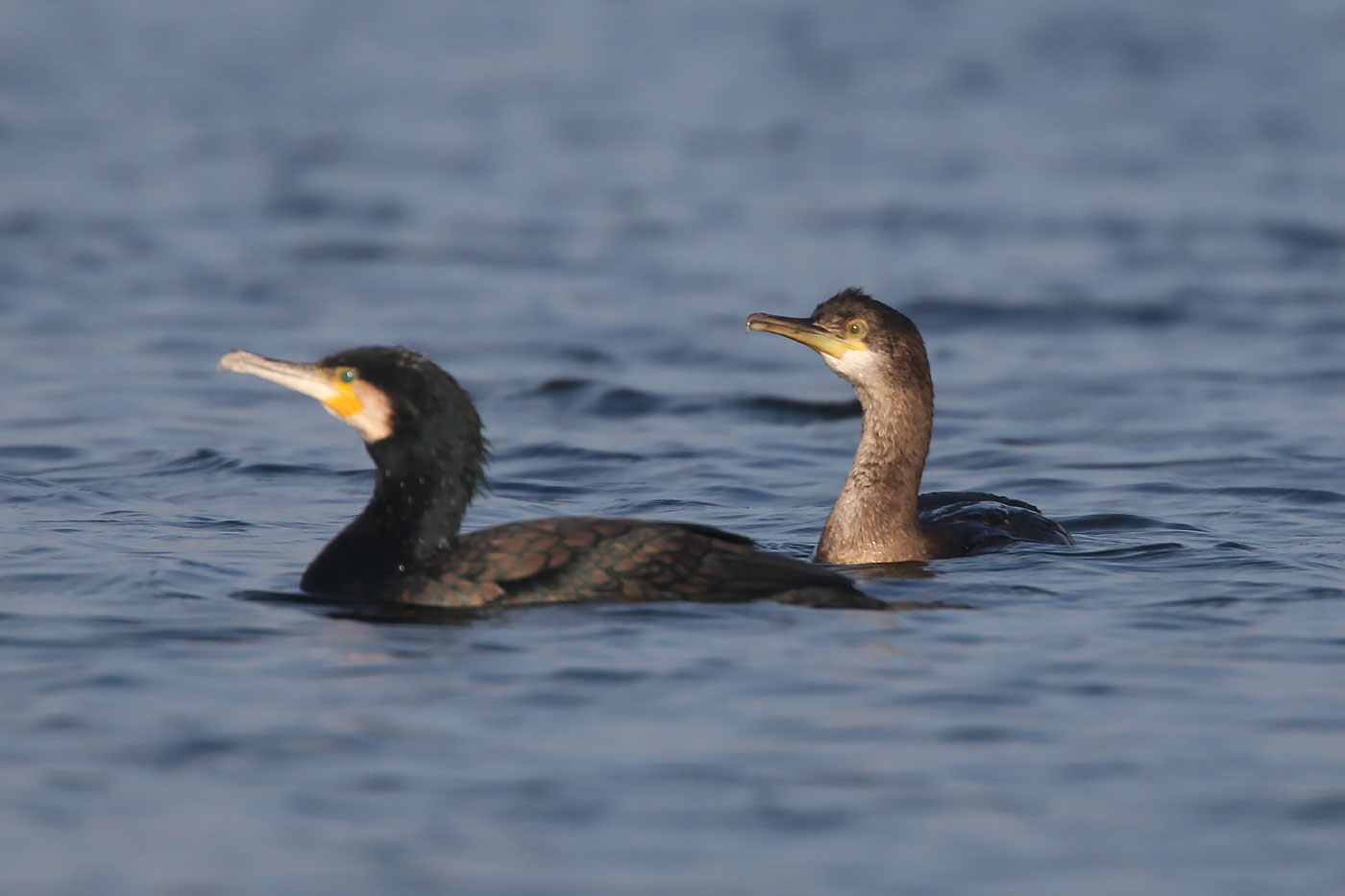
Adult Cormorant and juvenile Shag (Staines Reservoirs, Surrey, 19 November 2011). Although Shags are typically associated with rocky coastlines in the north and west, they occasionally turn up inland. In direct comparison, the larger size and greater bulk of the Cormorant are immediately apparent, as are the longer, heavier bill and more wedge-shaped bill and head profile. In contrast, the Shag is a positively delicate bird, with a slender bill, steep forehead and slim neck. Juvenile Shags are consistently pale brown on the fore-neck, with a contrasting white throat, a greeny-yellow lower mandible and a yellow gape line below the eye. The pale eye has a greeny-yellow orbital ring and the steep forehead shows a ruffled hint of the adult's crest (Andrew Moon).
- This article was originally published in the February 2015 issue of Birdwatch magazine.





